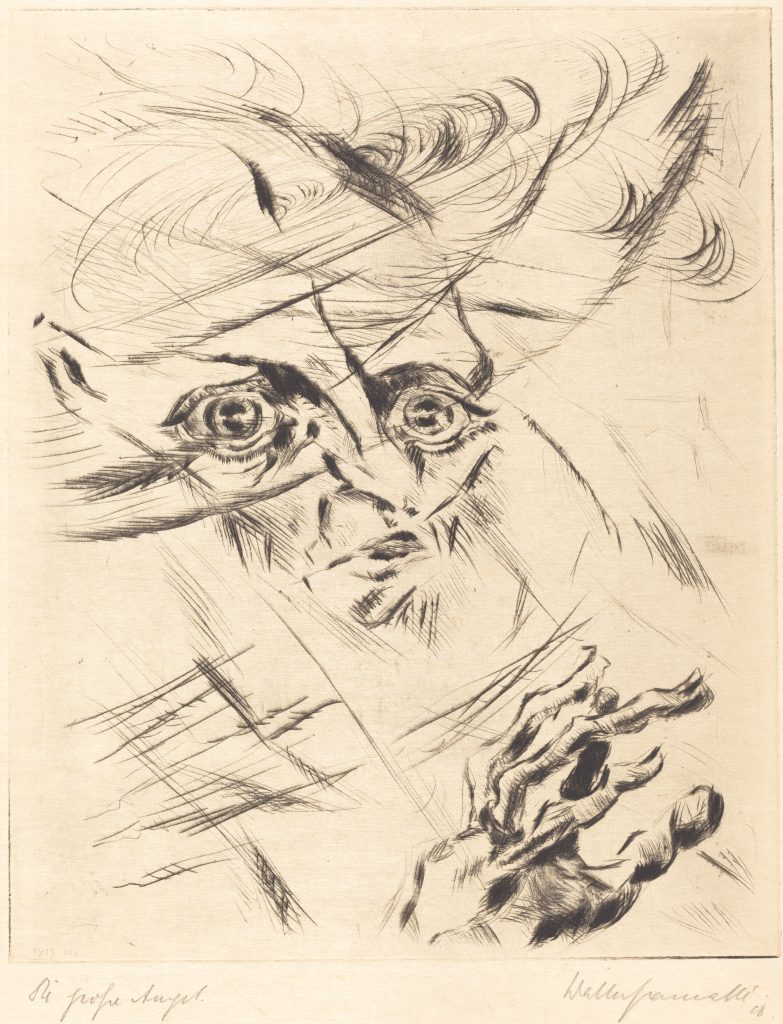9.2 Basic Concepts
Anxiety is a universal human experience that often includes feelings of apprehension, uneasiness, uncertainty, or dread in response to a real or perceived threat.[1] While fear is a reaction to a specific and present danger, anxiety often involves a vague sense of dread to a specific or unknown danger. However, the body reacts physiologically with the stress response to both anxiety and fear.[2] See an artistic depiction of a person facing their feelings of anxiety from a perceived threat in Figure 9.1.[3] Review the stress response in the “Stress, Coping, and Crisis Intervention” chapter.

Levels of Anxiety
Hildegard Peplau, a psychiatric mental health nurse theorist, developed a model describing four levels of anxiety that are categorized as mild, moderate, severe, and panic. Behaviors and characteristics can overlap across these levels, but it can be helpful to tailor interventions based on the level of anxiety the client is experiencing.[4]
Mild
Mild anxiety is a natural part of everyday life and can help an individual use their senses to perceive reality in sharp focus. Symptoms of mild anxiety include restlessness, irritability, or mild tension-relieving behaviors such as finger tapping, fidgeting, or nail biting.[5] These symptoms are generally manageable and do not significantly impair daily functioning.
Moderate Anxiety
As anxiety increases, the perceptual field narrows, and the ability of the individual to fully observe their surroundings is diminished/reduced. The person experiencing moderate anxiety may demonstrate selective inattention where only certain things in the environment are seen or heard unless they are pointed out. The individual’s ability to think clearly, learn, and problem solve is hampered, but can still take place. The physiological stress response kicks in with symptoms such as perspiration, elevated heart rate, and elevated respiratory rate. The individual may also experience headaches, gastric discomfort, urinary urgency, voice tremors, and shakiness; however, they may not be aware these symptoms are related to their level of stress and anxiety.[6]
Severe Anxiety
In severe anxiety, the perceptual field is significantly diminished, causing the individual to focus on either one specific detail or many scattered details. They often have difficulty noticing what is going on in their environment, even if it is pointed out, and may appear dazed or confused, exhibiting automatic behavior. Learning, problem-solving, and critical thinking become impossible at this level. Symptoms of the stress response intensify and may include hyperventilation, a pounding heart, insomnia, and/or a sense of impending doom.[7] See Figure 9.2[8] for an artist’s rendition of severe anxiety.

Panic
Panic is the most extreme level of anxiety that results in significantly dysregulated behavior. The individual is unable to process information from the environment and may lose touch with reality. They may demonstrate behavior such as pacing, running, shouting, screaming, or withdrawal, and hallucinations may occur. Acute panic can lead to exhaustion.[9] It is important to distinguish between the broad concept of panic and a panic attack. While panic refers to an intense experience of fear, a panic attack is a specific, acute episode marked by defined symptoms and diagnostic criteria. Panic attack is discussed in “Anxiety-Related Disorders” of Chapter 9.
Coping With Anxiety
Individuals may use several strategies to cope with anxiety. Coping strategies are an action, a series of actions, or a thought process used to address a stressful or unpleasant situation or modify one’s reaction to such a situation. Coping strategies are classified as adaptive or maladaptive. Adaptive coping strategies include problem-focused coping and emotion-focused coping. Problem-focused coping typically focuses on seeking treatment such as counseling or cognitive behavioral therapy. Emotion-focused coping includes strategies such as engaging in mindfulness, meditation, or yoga; using humor and jokes; seeking spiritual or religious pursuits; engaging in physical activity or breathing exercises; and seeking social support. Maladaptive coping responses include responses such as avoidance of the stressful condition, withdrawal from a stressful environment, disengagement from stressful relationships, and misuse of alcohol or other substances.
Defense mechanisms are reaction patterns used by individuals to protect themselves from anxiety that arises from stress and conflict. Adaptive use of defense mechanisms can help people achieve their goals, but excessive or maladaptive use of defense mechanisms can be unhealthy.[10] Excessive use of defense mechanisms are associated with specific mental health disorders.
Read more about coping strategies and defense mechanisms in the “Stress, Coping, and Crisis Intervention” chapter.
- Halter, M. (2022). Varcarolis’ foundations of psychiatric-mental health nursing (9th ed.). Saunders. ↵
- Halter, M. (2022). Varcarolis’ foundations of psychiatric-mental health nursing (9th ed.). Saunders. ↵
- “fear-g84d457182_1280” by mohamed_hassan on Pixabay.com is licensed under CC0 ↵
- Halter, M. (2022). Varcarolis’ foundations of psychiatric-mental health nursing (9th ed.). Saunders. ↵
- Halter, M. (2022). Varcarolis’ foundations of psychiatric-mental health nursing (9th ed.). Saunders. ↵
- Halter, M. (2022). Varcarolis’ foundations of psychiatric-mental health nursing (9th ed.). Saunders. ↵
- Halter, M. (2022). Varcarolis’ foundations of psychiatric-mental health nursing (9th ed.). Saunders. ↵
- “Walter_Gramatté,_Die_Grosse_Angst_(The_Great_Anxiety),_1918,_NGA_71292.jpg” by Walter Gramatté is licensed in the Public Domain. ↵
- Halter, M. (2022). Varcarolis’ foundations of psychiatric-mental health nursing (9th ed.). Saunders. ↵
- Halter, M. (2022). Varcarolis’ foundations of psychiatric-mental health nursing (9th ed.). Saunders. ↵
A universal human experience that includes feelings of apprehension, uneasiness, uncertainty, or dread resulting from a real or perceived threat.
The most extreme level of anxiety that results in significantly dysregulated behavior.
An action, series of actions, or a thought process used in meeting a stressful or unpleasant situation or in modifying one’s reaction to such a situation.
Reaction patterns used by individuals to protect themselves from anxiety that arises from stress and conflict.

